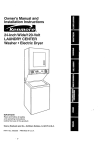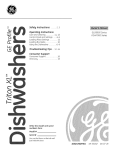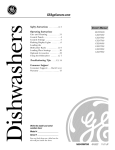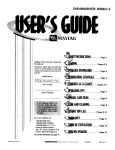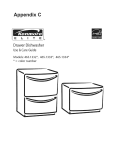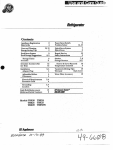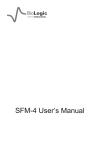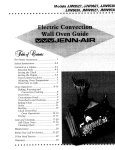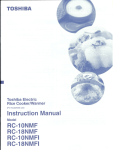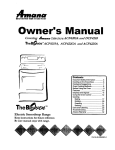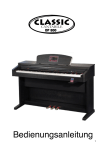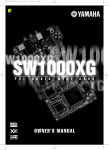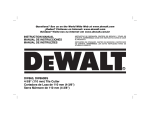Download Jenn-Air DW700 Dishwasher User Manual
Transcript
mWWJENN-AIR Use and Care Manual Dishwashers Models f I DW700, DW710, DW730, DW760 & DW860 I I Model DW860 I For Future Reference ................................................................................................................... Important Information ................................................................................................................... Safety Instructions ....................................................................................................................... Using Your Dishwasher ............................................................................................................ Hot Water is Essential .............................................................................................................. Page 2 2 3 4-7 4 Preparing Dishes ...................................................................................................................... Loading Your Dishwasher ..................................................................................................... Using Detergent and Rinse Aid ............................................................................................. Selecting Cycles and Options/Starting the Dishwasher ....................................................... What Can and Cannot Be Washed ............................................................................................ Special Tips ........................................................................................................................... For Best Results ..................................................................................................................... Water Conditions .............................................................................................................. Energy Saving Tips ................................................................................................................ Caring for the Dishwasher ................................................................................................ Winter Storage ........................................................................................................................ Changing Panels .................................................................................................................... Before You Call For Service ................................................................................................ 4 4-6 6-7 8-9 10 11-13 11 11-1 2 12 12-13 13 13 14-15 Warranty ...................................................................................................................................... 16 Congratulations on your choice of a Jenn-Air dishwasher. Your dishwasher has many features that offer you excellent cleaning and capacity along with energy efficiency. MODELNUMBER SERIAL NUMBER (numbersappearontheserialplateontheupperleflcornerofthelub _atePurchased Before you begin using your new dishwasher, pleasetake a few minutesto read and become familiar with the instructions in this book. By following the instructions carefully, you will be able to achieve excellent results with your dishwasher. JENN-AIR DEALER FROM WHOM PURCHASED ADDRESS CITY PHONE Should you have any questions about using AUTHORIZED JENN-AIR SERVICE CONTRACTOR your Jenn-Air dishwasher, write to us. Be sure to provide the model and serial numbers. ADDRESS Jenn-Air Customer Assistance c/o Maytag Customer Service P.O. BOX2370 Cleveland, TN 37320-2370 CITY PHONE IMPORTANT:Retainproofofpurchasedocumentsforwarrantys WARNING- Check with installer to makesure appliance has been grounded to avoid possible electrical shock. Be sure you read the IMPORTANTPERSONALSAFETY INSTRUCTIONSon page 3 before you start to use this dishwasher. 2 Products with a UL label have been listed with the Underwriters' Laboratories, Inc. - those with a CSAtag have been listedwith Canadian Standards Association. Nevertheless,as with any other equipment using electricity and moving parts, there is a potential hazard, WARNING - When using your dishwasher, follow basic precautions, including the following: 1. Read all instructions before using the dishwasher. 8. Be careful not to touch the heating element on the bottom of the tub during or at the completion of a cycle. It may be hot. 9. Use only detergents and rinse additives designed for an automatic dishwasher. Never use soap, laundry detergent, or hand washing detergent in your dishwasher. Keep these products out of the reach of children. 10. Do not sit, stand on or abuse the door or dish racks of the dishwasher. 2. Use the dishwasher only for its intended function. 11.WARNING: Under certain conditions, hydrogen gas may be produced in a hot water 3. Disconnect electrical power todishwasher system that has not been used for two before attempting to service, weeks or more. Hydrogen gas is explosive. If the hot water system has not been 4. To avoid electrical shock hazard, the sides used for such a period, turn on all hot water and back must be enclosed, and the front faucets and letthe water flow from each for panels must be attached before electrical several minutes. This will release any acpower is applied to the dishwasher. Refer cumulated hydrogen gas. As the gas is to the installation instructions for proper flammable, do not smoke or use an open grounding procedures, flame during this process. 5. Connect to a properly rated, protected and 12. Do not wash plastic items unless marked sized power supply circuit to avoid electri"dishwasher safe" or the equivalent. For cal overload, plastic items not so marked, check the manufacturer's recommendations. 6. Children should never be permitted to operate, or play in, with, or around this dish- 13. Do not tamper with controls. washer, 14.Always remove the door to the washing 7. To reduce the risk of injury when loading compartment when removing an old dishitems to bewashed, sharp or pointed items washer from service or discarding it. should be located with the handles up. Also, load sharp items so they are not likely to damage the door seal. SAVE THESE INSTRUCTIONS For proper performance of your dishwasher, hot water is necessary to activate the dishwasher detergent and melt fatty food soils. Set your water heatertodeliveraminimum of 120OFwater to the dishwasher, Models DW700 & DW710 -The heatingelement in your dishwasherwill turn on automaticallyto heat the water duringthe mainwash of all cycles (theheatingelementwillnotbe on duringRinse& Hold). • Certain foods, such as mustard, mayonnaise, lemon juice, vinegar, salt or dressings may cause stainless steel flatware to rust and pit if allowed to remain in contact with the surface for a period of time. Therefore, it is best to rinse these food soils off stainless steel flatware unless the dishwasher is to be operated soon after loading. • If your dishwasherdrains into a food waste disposer,make certain the disposer is cornpletelyempty before startingthe dishwasher to providefor properdraining. Model DW730 - Automatic AccuTempTM in the Normal and Heavy cycles will thermostatically heatthe water duringthe mainwash and extend Seldom will householdshave identical dishes. heatingif neededuntilthe properwater tempera- The number and type of articles used will vary ture is reached, daily.Your dishwasheris designedto be flexible and accommodatea wide variety of dishes and Models DW760 & DW860 - The AccuTempTM utensils.The followinginstructionsand drawings Option willthermostaticallyheat the water during will helpyou becomefamiliarwithyour dishwashthe mainwash and extendthe heating,if needed er. With experience, you will learn the best aruntil the proper water temperature is reached, rangement for your particular needs. To check water temperature, turn on the hot water faucet nearest the dishwasher. Let water run into aglass until it is as hot as possible, then check with a candy or meat thermometer. If the temperature at the faucet is below 120°F have a qualified General Recommendations • Place all items on the racks so they are separated and face the center to insure the water spray will reach the soiled allow items to extend out of surfaces. the racks.Do not person raise the water heater thermostat setting. • Make sure the movement of the upper and lower spray arms is not blocked by items hanging below the lower rack or tall articles in the upper rack. For more information, see page 11. • Insure the free flow of water to the detergent • It is not necessary to rinse dishes before placing them in your Jenn-Air dishwasher. Simply scrape off bones and large pieces of food. • Foods that have been burned onto cooking utensils will need to be scraped or soaked. cup by not blocking it with large items. • Larger, flat, lightweight items (such as plastic covers) may be wedged next to the silverware basket or along the sides and back of the racks. • The wash tower rises through the center ofthe lower rack during the cycle. For the best cleaning results, avoid blocking it or loading tall articles next to it. Upper Rack The upper rack is designed to hold glasses, cups, saucers, small plates, bowls, etc. Bowls fit securely in the back right hall'of the top rack. Small plates, such as salad plates or saucers, can be loaded in front of the bowls, facing the center. Glasses and cups of varying sizes can be loaded with flexibility in the center and left side. If additional space is needed for loading small plates, the left set of rack tines can also be used. Lower Rack Large dinner plates and other dishes may be placed in any convenient location in the lower rack with soiled surfaces facing the center. Small plates, saucers or shallow bowls may be loaded in the elevated area behind the wash tower. When loading glassware, leave a small space between each piece so they do not touch each other during the wash cycle, Do not place glasses over the tines. Instead,restthem againstthe sideof the rackortines. The back halfof the lower rack can accommodate either large dinner plates or two parallel rowsof smallerplates. The right side has wider spacing to accommodate large baking pans and bowls, Fold Down Shelf and Removable Tray - Model DW860 Only A fold-downshelf can be found on the left sideof the upper rack. It will hold tall, difficult-to-load items such as long*handled spoons, wire whisks, spatulas and knives. When the shelf is down small glasses and cups can be loadedunderneath it. The shelf can be raised to load taller glasses and mugs. A removable utensil tray sits on top of the upper rack and holds long, awkward items such as spatulas, serving spoons, knives, etc. When using the tray, be sure items do not block the upper wash arm. 5 Models DW730, DW760 & DW860-The left side of the lower rack has a section of lift-out tines, When in place the tines will hold plates of various sizes.To remove the tines, press inward on the front portion of the section and lift up to remove. Use the covered section for small, lightweight articles such as measuring cups and spoons, small plastic items, baby spoons, etc. Lower the cover to keep these items in place. I Models DW730, DW760 & DW860 When removed, wide and tall items such as JennAir grill accessory parts, muffin tins, baking pans and casserole dishes can be placed in this section. J NOTE: Models DW700, DW710 and DW730 Silverware basket doesn't include a handle. Detergent Use only a powder or liquid detergent designed for an automatic dishwasher. Never use soap, laundry detergent or hand dishwashing detergent in your dishwasher as it will cause severe oversudsing. Use fresh detergent and store it in a cool, dry place (not under the kitchen sink). Recommended Models DW730, DW760 & DW880 Flatware Put flatware in the removable silverware basket, mixing knives, forks and spoons. To prevent them from nesting together, place some handles up and some down. However, sharp or pointed items should always be loaded with the handles up. The silverware basket may be removed for ease of loading or unloading. Amount to Use The amount of detergent to use depends on the water hardness (measured in grains per gallon-gpg) and the amount of soil on the dishes. Generally detergent amounts should be increased for harder water and heavier soil. Too little detergent can result in poor cleaning, hard water filming and spotting, and poor drying. Overuse of detergent (especially in chemically softened water) can cause permanent etching (cloudiness) of glassware. For detergents with low phosphate content (8.7% or less) the usage level may have to be increased. The phosphate content is shown on the side of the box. 6 A basic guideline is one teaspoon of detergent for each grain of water hardness (gpg). Use a minimum of three teaspoons (one tablespoon) in soft water. Refer to the chart below, Light - Models DW730, DW760 & DW860 Place the proper amount of detergent in the Main Wash cup only. Close the lid. The detergent willbe released automatically into the main wash. NOTE: Rinse & Hold Do NOT use detergent with this cycle. WhenusingUItradishwasherdetergents, follow the package recommendations on the amount to use. Water Hardness* Soft (0-3 grains) Medium (4-9 grains) Hard (10-12 grains) Rinse Aid Your Jenn-Air dishwasher features an automatic rinse aid dispenser, located near the detergent dispenser on the door interior. Rinse aid improves drying results and reduces spotting and filming. Detergent Use 3 teaspoons (fillcup to first line) 4-9 teaspoons (fillcup to secondor thirdline 10-12 teaspoons (fillcup to level full) To fill, turn dispenser cap counterclockwise to open. Remove cap and pour liquid rinse aid into the opening. Replace cap and turn clockwise. * Your local water utilitycan tell you the exact degree of hardnessof your water supply.In rural areas, your state universityextensionservice can tell you howto test your waterhardness, The clear indicator in the center of the cap changes from dark to light when the reservoir is nearly empty. This indicates that it is time to refill the dispenser. Note: When the cap is removed and an "E" can be seen at the bottom of the rinse aid dispenser, it is empty. For water hardness of 13-14 grains, add additional detergent (1 teaspoon for each grain over 12) at the beginning of the main wash portion of the cycle. (Open door, add detergent to bottom of tub, close door and dishwasher will continue through cycle.) If water is 15 grains or harder, it will be virtually impossible to get good results with any dishwasher. The only solution is a mechanical water softener to improve water quality. Adding Detergent Add Detergent to Dispenser Cup Just Before You Se/ect the Cyc/e and Options. Normal or Heavy Place the proper amount of detergent in both the Prewash and Main Wash cups. Close the lid. Detergent will be released automatically into the prewash and main wash. 7 _ JI_NN -AI_ _ • aD D u on _. • • H_nQ , • " ivied Slid i ll._] Wash m Model DW860 Rinse & Hold Rinse Use to rinse a relativelyfew soiled dishes which are to be held untilthe dishwasheris full.Turn to Rinse& Hold on dial. Light** Use for chinaand crystaland for loads containingmedium to lightamountsof soil.Press Lightbuttonand turnthe dial to Start. PreWash ] Rinse / MainWash 2 Rinses Dry Normal Use for washing loads containing normallysoileddishes. This would include dishloads with problem soils. Press Normal button and turn the dial to Start. (Note DW700 Owners: Turn dial to Normal.) PreWash 2 Rinses Main Wash 2 Rinses Dry Heavy Use for loads with heavy or dried soils. Press Heavy button and turn the dial to Start. (Note DW700 Owners: Turn dial to Heavy.) PreWash 2 Rinses Main Wash 3 Rinses Dry 5 Min. 13 Min. (DW700 only) 1.5 Gal. 3.0Gal.(DWT00only) 7.5 Gal. 45 Min. 25 Min. 70 Min. + Heating Delay* 9 Gal. 9.5Gal.(DW700only) ' 55 Min. 25 Min. 80 Min. + Heating Delay* ' 65 Min. 10.5 Gal. 11Gal.(DW700Only) .125Min. 90 Min. + Heating Delay* * The dishwashermay extendthe mainwash to heatthe water to propertemperature. On ModelsDW730, DW760& DW860,the heatingdelayindicatorwill lightwhenthe cycleis beingextendeddue to lowwater temperature.NOTE:ModelDW730doesn'thavea heatingdelayfor the Lightcycle. ** Lightcycleis availableon DW730,DW760& DW860modelsonly. AccuTempTM - Models DW760 & DW860 Only If, for any reason, the incomingwater is below 120°F, press the AccuTempTM buttonto insure the water is heatedto the propertemperaturefor best cleaningand drying results. If the water temperature is low, the main wash will be extended and the Heating Delay indicator light will glow. On - The On lightwill glow during all washes, rinsesand the dryingperiod. Heating Delay -The HeatingDelay lightindicates the mainwashis beingextendedto heatthe water to the propertemperature. Press the Cancel buttonto cancel this option. Clean (Models DW760 & DW860 only) - The Clean light will glow after the drying period is This option is not available in the Rinse & Hold completed as a reminderthat the dishes have cycle, gonethrougha washand dry cycle. It will remain lit until the dial is manually turned to the Off Heat Dry position (vertical line after the dry section). Selectthisoptionto provideheat forfasterdrying. Delay Start (Model DW860 only) - The Delay Fan Dry - Models DW710 & DW730 Only Start lightwillglowduringthe Delaytime period. It Depressthisbuttontoturnthe heatingelementoff willgo off whenthe dishwasherstarts. duringthe fan dry cycle. Cancel - Models DW760 & DW860 Only Press the Cancel buttonto cancel the Heat Dry AND/OR theAccuTempTM options.NOTE: If heat dry has been cancelled, a fan will still operate duringthe dry cycle. For best cleaning,the forgotten item shouldbe added early in the cycle. 1. Unlatchthe doorand wait untilthe soundof circulatingwater stops. Delay Start - Model DW860 Only Select thisoptionto delaystartthe dishwasherfor approximately1 - 6 hours.To select,turnthe Set Dialto the desirednumberof hours. 2. Open the door and add the item. 3. Closethe doorand pause brieflybeforelatching the door. The cycle will continue at the pointit was interrupted. Note: Run the water from the hot water tap to clear the line of cold water before starting the dishwasher. After loading, press the button for the desired wash cycle (Heavy, Normal or Light). Pressthe buttonforthedesiredoptions.Setthe dialtoStart. Note DWT00 Owners: Turn the dial to desired setting. To selectRinse & Hold set the dial at the beginningofthe Rinse&Holdsection.AccuTempTM and Heat Dry are notavailablewiththiscycle. After selectingthe cycle and options press the dooruntilit latches.The motorwillrunfora minute ortwobeforethe dishwasherbeginsto fill.The On indicatorwill light. 9 Most tableware, cookware and silverware can be safely washed in your Jenn-Air dishwasher. If you have any doubts about a particular piece of dishware, check with the manufacturer to see if it is dishwasher safe. If you cannot reach the manu- Yes, except anodized aluminum and some cookware. High water temperature and detergents may affect finish. Check cleaning instructions. No, except for Jenn-Air grill-rocks Seasoning will be removed, and iron will rust. Yes, except antique or handpainted china, Always check manufacturer' recommendation before washing. Antique handpainted orover-theglaze patterns may fade. Gold leaf may discolor. If in doubt, test-wash a small item for several weeks beforewashing an entire set. Yes, except antique or lightweight delicate crystal, Yes, except milk glass, facturer, simply test-wash a small item for several weeks before attempting to wash an entire set. Remember: It is the user's responsibility to determine if dishware should be washed in a dishwasher. No Cannot withstand high water temperatures and detergents. Yes(If labeled Always check manu"dishwasher facturer's recommendasafe") tionbeforewashing. Plastics vary in their capacity to withstand high water temperatures and detergents. Yes RunaRinse&HoldCycle if not washing immediately. Prolonged contact with foodscontainingsalt, vinegar, milkproductsor fruit juice could damage finish. Always check manufacturer's recommendation before washing, Some types of leaded crystal may etch with repeated washings, if in doubt, test-wash a small item for severalweeks beforewashing anentireset. Yes, except those with commercial "darkening". Note: Do not wash with stainless steel or copper, RunaRinse&HoldCycle if not washing immediately. Prolonged contact with food containing salt, acid or sulfide (eggs, mayonnaise and seafood) could damage finish. Commercial"darkening" may be removed by detergent. Milk glass will yellow with repeated dishwasher washing. No May rust. No Will discolor. No No High water temperatures and detergent may discolor or pit finish. Always check manufacturer'srecommendation before washing. Wood may warp, crack or discolor. 11) Hot Water is a Must Hot water dissolves and activates the dishwashing detergent, dissolves grease on dishes and helps dry glasses spot-free. Make certain all loads are washed in hot water. Ways to have a reliable hot water supply... 1. Maintain a minimum of 120°F water supply at central water heater. To check water temperature, refer to page 4. 2. Let the water from the hot water tap run to clear the line of cold water before selecting a cycle, 3. Let the water heater recover if you have recently done laundry. 4. Models DW760 & DW860 Only - If your hot water is below 120°F it will be necessary to selecttheAccuTempTMoptiontoachievegood results. AccuTemp TM will add heat during the main wash and thermostatically check the water temperature. If the proper temperature is not reached during the standard main wash time, the heating delay indicator will light and the cycle will be extended until the temperature is reached, Use Enough Detergent For proper soil removal and to prevent filming, etching and spotting, an adequate amount of detergent must be used. We recommend 1 teaspoon of detergent per grain of water hardness with a minimum of 3 teaspoons. See page 7 on adding detergent. Use a Rinse Aid Using a rinse aid improves drying results and reduces spotting and filming. See page 7 for instructions on using a rinse aid. Select the Proper Cycle The cycle needed depends on the amount of food soil. See page 8 for cycle descriptions. Select Heat Dry For faster drying select Heat Dry. Hard Water Deposit If an unusual amount of calcium is in the water, a lime film or deposit may eventually build up on the dishes and interior surface of the dishwasher. You may first notice this as "cloudy" glasses. To determine if the film on the glasses is due to hard water, soak a glass approximately 15 minutes in undiluted white vinegar. Rinse and dry. If film is removed, it is due to hard water (if not removed, see Soft Water Etching). To correct: 1. Increase the amount of detergent used according to the degree of water hardness. (See p. 7.) 2. Check the water temperature. (See p. 4.) 3. Use a rinse aid to improve the sheeting action of the water. (See p. 7.) To remove film from dishwasher one of the following: interior, try 1. Remove with a damp cloth and a mild scouring powder. 2. Startemptydishwasheron Rinse&Holdcycle. During fill, open door and add 1/3 cup RoVer Rust Remover to water. Allow dishwasher to complete cycle. Do not use detergent. Follow with a regular detergent wash. Load the Dishwasher Properly To insure that all soiled surfaces get adequate wash action, carefully follow the instructions for loading the dishwasher. (See pp. 4-6.) Make sure nothing extends above or below the racks to interfere with the movement of the upper or lower spray arms. 11 Soft Water Etching If the cloudy film is not removed after soaking in vinegar (previous procedure), then the condition is etching. This permanent film occurs in unusual conditions under which the surface of the glass is pitted or eroded. It is permanent, In the beginning stages, etching may be identified by a"rainbow" look--shades of blue, purple, brown or pink may be seen when the glass is held at an angle to the light. In advanced stages the surface of the glassware appears frosted, spotted or cloudy, Certain types of glassware will etch in any dishwasher with the combination of soft water (especially mechanically softened), an excessive amount of detergent, heat and prerinsing. There is no relationship to the cost or quality of the glass, To prevent: 1. 2. 3. 4. Adjust the amount of detergent to the degree of water hardness. (See p. 7.) Lower the water temperature to 120°F. (See p. 4.) Avoid using the Heat Dry drying option. Do not manually pre-rinse dishes before loading in dishwasher. Pre-rinsing prior to loading to remove all food soil aggravates etching, Rust You can help save energy if you: 1. Wash full loads. Running a half-filled dishwasher uses the same amount of electricity and hot water as a fully loaded machine. 2. Do not pre-rinse normally soiled dishes. Select the correct cycle for the load and use the recommended amount of detergent for good washing results without hand rinsing. 3. Load correctly for best washing results. Incorrect loading may cause poor washing and the need to prewash all or part of the load. 4. Use the Light cycle when dishes are lightly soiled. It uses less hot water and energy than other cycles. 5. Most models - fan dry dishes (without heat) when you don't need them dried quickly. Allow longer drying times (overnight). 6. Use your dishwasher during off-peak hours. Local utilities recommend this to avoid heavy usage of energy at certain times of the day. Check with your utility company to see if offpeak rates exist. The interior is normally self-cleaning. Occasionally check the bottom of the dishwasher tub and clean out pieces of food which may collect there. Sometimes the dishes or the interior of the dishwasher may turn a brown, red or black color if iron or manganese is in the water. To remove discoloration from the dishwasher interior, dishes and Periodically clean the bottom edge of the dishwasher door liner. Food and liquids drip onto this area when the dishwasher is loaded. glassware (no metal items): If you notice an odor in your dishwasher, it may be due to a strong "chemical" or chlorine odor from the dishwasher detergent. Using a different detergent, especially a lemon scented one, will probably eliminate the odor. In some instances the smell of the rinse aid may be strong. Purchase a fresh package and see if it is better. Lastly, if the dishwasher is run only every couple of days, an odor may develop. Use the Rinse & Hold cycle daily to remove any food soil that may cause an odor. 1. Select a rust removing compound, such as RoVer Rust Remover. It is available from dealers by using Part No. 057961. 2. Start empty dishwasher on Rinse & Hold or rinse portion of the cycle. During fill, open the door and add 1/2 cup RoVer Rust Remover to the water. Allow the dishwasher to complete the cycle, 3. Follow with a detergent wash. The only permanent solution is to install special filters which can remove iron and manganese from the water. 12 To remove an odor, try one of the following: 1. Place baking soda in both sides of the detergent dispenser, Select the Light cycle and let the dishwasher runfor about 20 minutes, Stop the dishwasher by unlatching the door and let stand overnight. Then, restart the dishwasher by latching the door and let it complete the Your Jenn-Air dishwasher comes with reversible panel inserts which are pre-assembled at the factory This enables you to select the color you want before your dishwasher isinstalled orchoose another color at a later date. cycle. 2. Select the Light cycle and let the dishwasher fill with water. Then open the door and pour 1/4 cup of chlorine bleach into the bottom of the dishwasher. Latch the door and let the dishwasher complete the cycle. Do not use detergent. To Change Panels Clean the control panel and front panel with a soft damp cloth and liquid spray cleaner. Do not use any abrasive powders or cleaning pads. CAUTION: To protect against rupture of fill valve, BE SURE the water lines leading to the dishwasher, are well protected against freezing, 1. Run dishwasher through a cycle using detergent. If an odor remains, repeat using baking sodain the dispenser cup or adding 1/4cupof chlorine bleach in the bottom of the tub. Clean the bottom edge of the door and front lip of the tub with a baking soda and water solution, 2. Turn the water supply off and set the dishwasher to drain (select Rinse & Hold cycle). Once Rinse & Hold is completed, open the door and return Timer to Off. 3. Disconnect the electrical supply, 4. Place a pan under the drain outlet. Disconnect the flexible tubing from the pump and drain the water into pan by pushing down on drain arm lever. Reconnect hose and secure clamp, 5. Prop the door open. To restore service, turn on the electricity and water supply. Select a wash cycle and let the dishwasher complete the cycle. Check connections to make sure they are water tight, Door Panel 1. Remove three screws holding the side trim strip on one side of the door. Take note of how the trim comes off. 2. Grasping the lower part of the door panel(s), bow panel(s) out carefully at the bottom while sliding panel(s) far enough to clear the flange on the trim strip which was not removed and remove panel(s). 3. Arrange panel so the desired color is facing out. 4. Place door panel(s) (notched side up) behind the metal trim at the bottom of the door. Bow the panels so they fit behind the control panel at the top. 5. Slide the panel(s) under the side metal trim which was not removed. To do this, it will be necessary to compress the backing behind the colored panel(s). 6. Reinstall the side trim which was removed earlier. Align the holes and replace the three screws. Lower Panel - Most Models 1. The lower access panel is held by four screws (two above the panel and two below). With these removed, the panel may be removed to make it easy to change panel colors. 2. With the lower access panel removed, remove the four screws along the bottom of panel and remove the trim which holds the panels. Once the desired panel is facing out, replace the trim, and reinstall the panel to the dishwasher. Use care when changing panels to be certain you are not injured on sharp edges and that the panels are not damaged. If you have any questions concerning changing panels or wish to purchase a different color panel, contact your local Jenn-Air dealer. 13 Check these points if your dishwasher... • Increase detergent use according to water hardness. • Check for improperloadingand do not overload. Dishesshouldnot nest together. • Plasticitems havea poroussurfaceand tend to holdwater. Towel dryingmay be required. • Glasses,cups,etc.,withconcavebottomswill hold water. Leaves food soil on dishes • Check to see that the water heater is set to delivera minimumof 120°F water at the faucet. • Turn on hotwater at kitchensinkbefore running the dishwasher to be certain that hot water is entering the first wash cycle. • Models DW760 & DW860 Only - Select the Stains or discolors dishes AccuTemp TM option. • Aluminum utensils can leave markswhen they • Checkwater hardness. Forextreme hardwater rub against other things. Load properly. conditions it may be necessary to install a e lrondeposits in the water can leave a yellow or mechanical water softener, brown film on dishes. You may desire to have eUse the amount of detergent recommended aspecialfilterinstalledinthewatersupplyline, for your water hardness, and be sure it is put or periodically use RoVer Rust Remover. (See in the dispenser as directed previously. Water Conditions, pp. 11-12.) • Use fresh high phosphatedetergent that is not caked. Store detergent in cool, dry place. Cycle takes too long • Select proper cycle for soil level of dish load. (Heating Delay light stays on) • Be sure dishes are loaded properly with noth• Model DW730 - The water temperature is too ing blocking the path of the wash arms, center low and the dishwasher is automatically exspray nozzle or detergent dispenser, tending the cycle to heat water to the proper • Check for nesting of dishes that prevents temperature. water from reaching all surfaces. • Models DW760 & DW860 - The AccuTempTM • Check to make sure glasses are not loaded option hasbeen selectedwhich willextend the over prongs, cycleto heatwater thermostaticallywhen water temperature is low. Leaves glassware cloudy or spotted • Adjust the detergent amount to your water Clean light remains on hardness as described earlier in this book. • Turn dial slightly clockwise until light shuts off. Avoid overuse or underuse of detergent. • Check to see that the water heater is set to Seems noisy deliver a minimum of 120°Fwater atthe faucet • Water circulation noise is normal. nearest the dishwasher. Avoid extremely high • Humming during drain is normal. or low temperatures. • Use a rinse aid such as Jet-Dry. • Do not pre-rinse dishes before loading them into the dishwasher. e Refer to Water Conditions for more information. (See pp. 11-12.) • Dishes may not be loaded properly. Dishes should not be touching one another. • Wash arm may be hitting an item when rotating. Load items so nothing blocks the wash arm. • Chopping or grinding noise may be heard during the cycle when the internal food disposer is chopping food. Does not dry properly • Be sure the Heat Dry option is selected, • Use a rinse aid. • Check to see that the water heater is set to delivera minimum of 120°Fwater at the faucet nearest the dishwasher. Run water and check temperature with a candy thermometer. • Detergent cup lid hits door liner when dishwasher door is opened at end of cycle and is normal. • Installation (location, flooring, cabinetry, etc.) can affect noise level. • Water valve hiss during fill is normal. 14 Does not run properly/Won't fill • Be sure door is tightly closed and latched. • Check to see that water is turned on. Has on odor • Soiled dishes held too long in the dishwasher can create an odor. Use the Rinse & Hold • The cycle is not properly selected. Be sure the dial is turned far enough or the cycle button is completely depressed, • Motor runs 1-2 minutes before fill begins. • Check your home's circuit breaker or fuse box. • Inlet hose may be kinked. • Water inlet valve may be clogged with sediment and in need of cleaning. cycle. • Dishwashers will have a "new" smell when first installed. • Dishwasher not draining properly. (See "Does not drain properly") Chips dishware • Be sure dishes are loaded according to the Does not drain properly instructions so they do not strike together • Check to see that the cycle has been comfrom the wash action. pleted. • We do not recommend washing fine an• Drain hose may be kinked, tique china and crystal in the dishwasher. • Checkyourhome'scircuitbreakerorfuse box. • Do not load glasses over rack tines, or Reset if necessary, allow to touch each other. • Foodis backingup in the pipesat the sink.If • Do not overload. hookedup to a food waste disposer,be sure to run the disposerregularly. • Some water is normaland keeps seals from drying. Detergent cup did not empty completely • Check to see that the cycle has been completed. • Be sure dispenseris not blockedfrom wash action. • Be sure dispenseris notwet when detergent is added. • Make sure largeitemsplacedinthe frontright corner of upper rack are not blocking the detergent cup. • Use fresh detergent.Store in dry, coolplace. Leaks • Checkto see that the dishwasheris level as describedin the InstallationInstructions. • Suds can cause the unitto overflowso measuredetergentcarefully.Try anotherbrandof detergent.Use only detergentsdesigned for automaticdishwashers. • Make sureyoufollowdirectionson howto add a forgottenitem. 15 DISHWASHER WARRANTY Full One Year Warranty i Any part which fails in normal home use during the first year after the date of original retail purchase, will be repaired or replaced free of charge. Limited Two Year Warranty Any partwhichfails in normalhome use duringthe secondyear from the date of originalretailpurchase,willbe repaired or replacedfree of charge for the part itself,with the ownerpaying all othercosts, includinglabor, Limited Five Year Warranty on Wash System and Solid State Controls Any parts of the system including the complete power module assembly, center spray nozzle, spray arms, top wash arm hose, motor, AND---on Computer Touch Control Models only--any microprocessor and touch pad assemblies which fail in normal home use during the second through the fifth year from the date of original retail purchase, will be repaired or replaced free of charge for the part itself, with the owner paying all other costs, including labor. Limited Five Year Rack Warranty (Available on Select Models) Shouldthe DuralonTM coatedracksrustduringthe five year periodstarting fromthe date of originalretailpurchase,repair or replacement will be made free of charge for the part itself, with the owner paying al7other costs, including labor. FULL TWENTY Year Warranty Against Leaks on Dishwasher Tub and Door Liner Shoulda water leak developin the tub or doorliner in normalhome use duringthe TWENTY YEAR periodstartingfrom he date of originalretail purchase,repair or replacementof the tub and/ordoor linerwill be made FREE OF CHARGE, These full warranties and the limited warranties apply when the appliance is located in the United States or Canada. Appliances located elsewhere are covered by the limited warrantiesonly, which include parts which fail during the first year. Canadian Residents Thiswarrantycoversonlythose appliances installedin Canadathathave been listedwithCanadian StandardsAssociation unless the appliances are brought into Canada due to transfer of residence from the United States to Canada. To Receive Warranty Service Call or write the JENN-AIR dealer from whom your appliance was purchased or the authorized service firm designated by the dealer. If you have moved from the selling dealer's service area call or write any authorized JENN-AtR dealer or authorized service firm at your new location. Check the telephone directory yellow pages to identify the dealer or service firm in your area. Second: Should your contact with the dealer or the service firm fail to satisfactorily resolve the problem, contact the ! manager of the dealership or the manager of the service firm for assistance. Third: Should you not receive satisfactory warranty service from one of the above or need help in identifying an authorized service firm write Jean-Air Customer Assistance, c/o Maytag Customer Service, P.O. Box 2370, Cleveland, TN 37320-2370, and arrangements for warranty service will be made. If the problem is urgent, caJI Jenn-Air Customer Assistance, c/o Maytag Customer Service at (800) 688-1100. First: When contacting Jean-Air Customer Assistance, c/o Maytag Customer Service be sure to include the model and serial number of your appliance, the name and address of the dealer from whom you purchased the appliance and the date of purchase. This Warranty gives you specific legal rights, and you may also have other rights which vary from state to state. Should you still have a problem, write to: Major Appliance Consumer Action Program, 20 North Wacker Drive, Chicago, Illinois 60606. MACAP is an industry sponsored but independent group of consumer experts who receive and act on complaints from appliance owners. NOTE: When writing about an unsolved service problem, please include the renewing information: (a) Your name, address and telephone number; (b) Model number and serial number (found on the upper left corner of the tub opening) of your appliance; (c) Name and address of your dealer and date the appliance was bought; (d) A clear description of the problem you are having; (e) Water hardness, detergent brand and amount, water temperature, and cycle used. JENN-AIR 3035 SHADELAND • INDIANAPOLIS. IN 46226-0901 Cat.No.DU760UE PartNo.6-913590 10/95
















